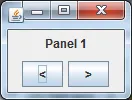我正在尝试创建一个小型GUI,它有2个JButton和2个JPanels,每个JPanels上都有一些绘图动画。默认情况下,它必须显示第一个JPanel,并通过单击第二个JButton来查看我的第二个JPanel。所以:我创建了JFrame、Panel1和Panel2,在其中绘制了我的动画,创建了Button1和Button2,并向它们添加了ActionListeners。我还有一个MainPanel,它在一个字段变量i中。通过更改这个"i",我的构造函数将Panel1(默认)或Panel2(通过单击JButton2来更改i)添加到MainPanel中。然后我将此MainPanel添加到我的frame中。所以我的问题是:在MainPanel类中,我有一个refreshMe方法,我应该在那里写什么才能使我的GUI正常工作?谢谢。以下是我的代码:
import java.awt.Color;
import java.awt.Dimension;
import java.awt.event.ActionEvent;
import java.awt.event.ActionListener;
import javax.swing.JButton;
import javax.swing.JFrame;
import javax.swing.JPanel;
public class GuiTest {
public static void main(String[] args) {
JFrame f = new JFrame();
MainPanel myPanel = new MainPanel();
f.add(myPanel);
Button1 button1 = new Button1();
Button2 button2 = new Button2();
myPanel.add(button1);
myPanel.add(button2);
f.setDefaultCloseOperation(JFrame.EXIT_ON_CLOSE);
f.pack();
f.setVisible(true);
}
}
class MainPanel extends JPanel {
Panel1 p1 = new Panel1();
Panel2 p2 = new Panel2();
public int i = 1; //this is being changed later by clicking JButton
// I use this setter later in actionPerformed in order to change i
public void setI(int i) {
this.i = i;
}
MainPanel() {
if (i == 1) {
this.add(p1);
}
if (i == 2) {
this.add(p2);
}
}
public void refreshMe() {
// Need some help here:
// I don't know what should I write, how to make a repaint of myPanel?
System.out.println("just test, if the method refreshMe working by clicking some button");
}
}
class Panel1 extends JPanel {
public Panel1() {
this.setBackground(Color.BLUE);
// a lot of drawing stuff going on here
}
@Override
public Dimension getPreferredSize() {
return new Dimension(200, 200);
}
}
class Panel2 extends JPanel {
public Panel2() {
this.setBackground(Color.GREEN);
// a lot of drawing stuff going on here
}
@Override
public Dimension getPreferredSize() {
return new Dimension(200, 200);
}
}
class Button1 extends JButton {
MainPanel someObj1 = new MainPanel();
Button1() {
setText("Show Annimation A");
addActionListener(new ActionListener() {
@Override
public void actionPerformed(ActionEvent e) {
someObj1.setI(1);
System.out.println("The variable i is now: " + someObj1.i);
someObj1.refreshMe();
}
});
}
}
class Button2 extends JButton {
MainPanel someObj2 = new MainPanel();
Button2() {
setText("Show Annimation B");
addActionListener(new ActionListener() {
@Override
public void actionPerformed(ActionEvent e) {
someObj2.setI(2);
System.out.println("The variable i is now: " + someObj2.i);
someObj2.refreshMe();
}
});
}
}
